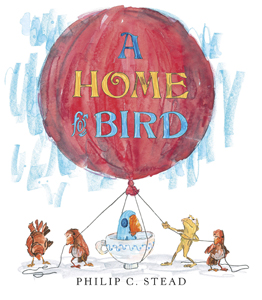A Home for Bird has been on my radar for a long time.
 A Home for Bird has been on my radar for a long time. I was on a recon mission at ALA for new books and I sneaked a slow peek while the Roaring Brook folks were busy. It took me a while to read it because I kept slowing down. There is just so much to take in.
A Home for Bird has been on my radar for a long time. I was on a recon mission at ALA for new books and I sneaked a slow peek while the Roaring Brook folks were busy. It took me a while to read it because I kept slowing down. There is just so much to take in.I need to admit right now that I love the loose, crayon-y strokes in this book. From the very first page (which is really the dedication page), I admired those strokes. The junker of a truck ("Careful Moving Co.") is exactly the kind of truck my dad would have loved. There it is, spilling over with junk: a rug, chair, birdcage, fishing pole and all the rest. The grey dog hanging off the back of the truck strikes the chord many of us feel when we move. And, what's this? A little bird has flown the coop, or been tossed out during the bump that has caused the back wheels to leave the road.
Well, that was quite a start.
The rest of the book is filled with the sort of delights that are fun to discuss. Vernon, a sweet frog with the heart of a collector, finds Bird. But, bird says nothing. Vernon concludes that Bird is missing his home, and he is just the frog to find it. The journey, "into the great unknown," has many twists and turns until Bird does find his home. It's these twists and turns that are so deeply satisfying. Seeing Bird in a mailbox and in another bird's nest is sad and fun at the same time and, at some point in the visual narrative, the young reader (and older one, too!) begins to have that delicious feeling of recognition. Oh, yes, those ARE the birdcage and the tablecloth from the truck. Is that the beachball on the road? And the teddy bear! And the dog!
When Bird finally is home, Vernon is happy. It's got that "And it was still hot" feel, doesn't it?
Though the words are beautifully understated, this is all about the illustrations. You can understand the plot, characters and emotions from these special (in Caldecott terms, "distnguished") pages. Still, we have a number of great themes here: friendship, home, working together, caring for others. Then there are the satisfying visual clues that draw the reader completely into the story. The art feels fresh and innocent, all gently handcrafted. If you read Jules Danielson's interview with Mr. Stead, you will understand the work that went into this seemingly simple book. Water-soluble crayons and gouache play very well together, but, with no computer involved, the slightest mistake means starting all over again.
But, I am glad he stuck with it.
says
says
says
says
says
says
says
says
says
says
says
says
says
says
Add Comment :-
RELATED
RECOMMENDED
ALREADY A SUBSCRIBER? LOG IN
We are currently offering this content for free. Sign up now to activate your personal profile, where you can save articles for future viewing.









